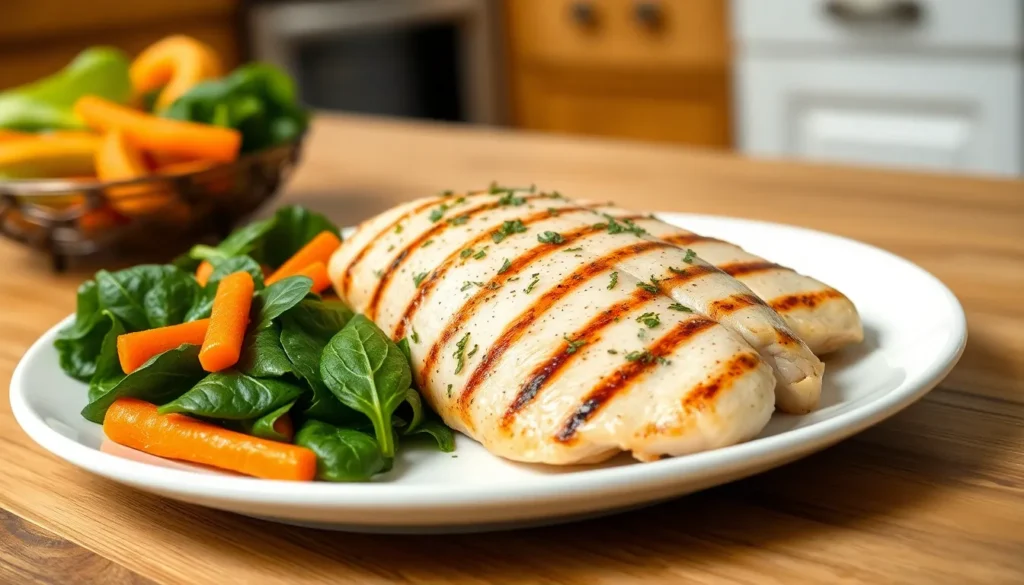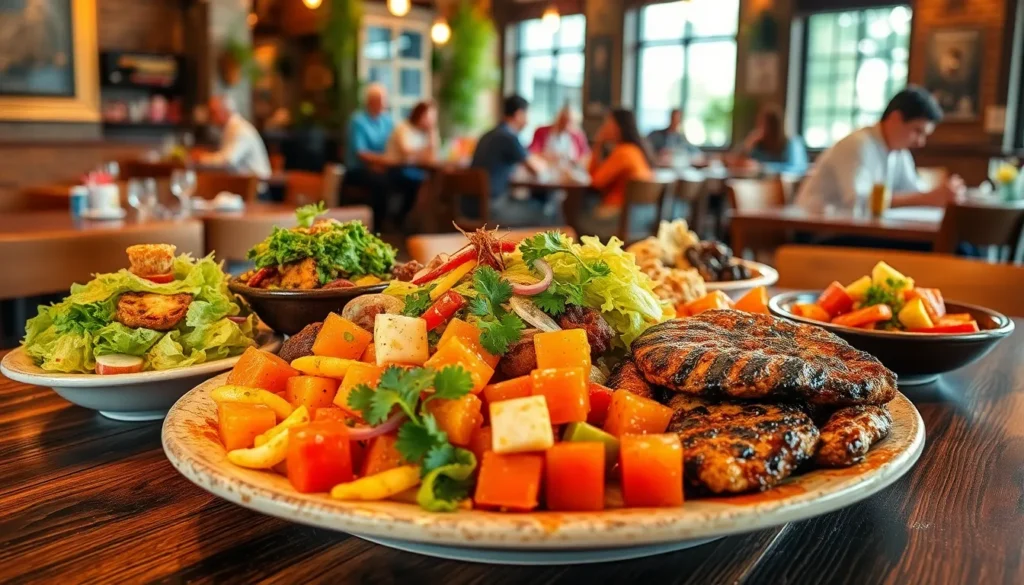Table of Contents
ToggleGout can feel like a sneaky thief, stealing joy from every delicious meal. And when it comes to chicken, the beloved poultry might just be the culprit that leaves taste buds in a tizzy. But is chicken really the villain in this drama?
Overview of Gout
Gout is a form of arthritis characterized by sudden swelling and pain, often occurring in the big toe. It results from elevated levels of uric acid in the blood, leading to the formation of crystals in the joints. Common triggers include certain foods, beverages, and lifestyle choices.
Diet plays a crucial role in managing gout symptoms. High-purine foods contribute to increased uric acid levels. Organ meats, certain seafood, and sweetened soft drinks rank among significant offenders. While chicken contains moderate purine levels, its effect on gout varies among individuals. Some people may experience flare-ups after consuming chicken, while others may tolerate it.
In addition, lifestyle factors significantly influence gout progression. Alcohol consumption, dehydration, and obesity heighten the risk of attacks. Each factor exacerbates uric acid production or hinders its elimination. The management of weight through healthy eating and regular physical activity proves beneficial.
Monitoring uric acid levels is vital for individuals with gout. Regular check-ups with healthcare professionals help track levels and adjust treatment plans as necessary.
Understanding symptoms and triggers is essential for effective gout management. Joint pain often accompanies swelling, particularly in the early stages. Recognizing patterns can aid individuals in avoiding certain foods and beverages that lead to flare-ups.
What Is Gout?

Gout represents a type of arthritis marked by sudden, severe pain and swelling. Its primary cause entails elevated uric acid levels in the blood, which form crystals in the joints.
Causes and Risk Factors
Several factors contribute to the development of gout. Genetics play a key role, making some individuals more susceptible than others. Diet influences risk; foods high in purines, such as red meat and certain seafood, raise uric acid levels significantly. Alcohol consumption, particularly beer, exacerbates this condition. Obesity increases stress on joints and elevates uric acid. Dehydration also heightens the risk since it reduces fluid levels needed for proper uric acid excretion. Age and gender contribute too; men face a higher risk until women reach menopause.
Symptoms of Gout
Gout symptoms often occur suddenly, frequently at night. Intense pain typically strikes the big toe but can affect other joints like the ankle or knee. Swelling, redness, and warmth accompany joint pain during an attack. Some individuals experience recurring episodes, with intervals of weeks or months between flare-ups. Chronic gout leads to joint damage over time due to repeated inflammation. Identifying these symptoms helps in seeking prompt treatment and managing flare-ups effectively.
Nutritional Profile of Chicken
Chicken provides essential nutrients while being a dietary staple for many. Understanding its purine content is crucial for those managing gout.
Purine Content in Chicken
Purine levels in chicken are moderate, typically ranging from 100 to 150 mg of purine per 100 grams. Individuals with gout may experience varying reactions to chicken consumption. Some studies indicate that occasional intake may not lead to significant flare-ups, while others suggest caution. Skinless chicken breast contains fewer purines than dark meat. Cooking methods also affect purine content; grilling and baking are preferable to frying. Monitoring personal responses to chicken is vital in managing gout effectively.
Comparison with Other Meats
Comparatively, red meats contain higher purine levels than chicken. Beef and lamb can exceed 200 mg of purines per 100 grams, increasing the risk of gout flare-ups. Fish and shellfish may also harbor elevated purines, especially sardines and mussels. On the other hand, poultry, including turkey, has similar purine profiles to chicken but tends to be moderately higher. Choosing chicken over higher purine options can offer a balanced approach for those managing gout symptoms.
The Relationship Between Chicken and Gout
Chicken’s role in gout management remains a topic of interest among researchers and health professionals. Moderate purine levels in chicken vary, but they generally range from 100 to 150 mg per 100 grams.
Studies and Research Findings
Research indicates mixed results regarding chicken consumption and its impact on gout flare-ups. Some studies suggest that individuals with gout may tolerate moderate amounts of chicken without triggering symptoms. Others emphasize that the specific cut of chicken might influence the outcome. For instance, skinless chicken breast contains lower purine levels compared to dark meat. In contrast, red meats consistently show higher purine content, often exacerbating gout symptoms. Several large observational studies highlight an overall dietary pattern rather than focusing solely on individual foods.
Expert Opinions
Experts recommend a personalized approach when considering chicken in a gout-friendly diet. Nutritionists often advise individuals to monitor their uric acid levels and assess their reactions to chicken consumption. Some specialists advocate for lean options, like skinless chicken breast, while cautioning against darker options. It’s important to note that everyone’s body reacts differently to foods. Many experts agree that moderation is key for managing symptoms. When combined with low-purine foods, chicken can potentially fit into a balanced eating plan.
Dietary Recommendations for Gout Sufferers
Managing gout requires careful dietary choices. Focus on low-purine foods, as these help lower uric acid levels. Include vegetables like spinach, kale, and carrots, which are nutrient-rich without high purine content. Fruits, particularly cherries and citrus fruits, also provide antioxidants and may reduce flare-ups due to their anti-inflammatory properties.
Incorporate whole grains such as brown rice and oats into daily meals. Legumes like lentils and beans serve as protein sources while remaining low in purines. Lean poultry options, such as skinless chicken breast, can be included in moderation. Chickpeas and tofu also work well for protein intake.
Limit high-purine foods, including organ meats and certain seafood. Red meats typically contain elevated purine levels and should be avoided or consumed sparingly. Alcohol poses a risk, particularly beer and spirits; thus, minimizing intake is beneficial. Hydration plays a crucial role, so drinking plenty of water aids in flushing out uric acid.
Monitor portion sizes to prevent overindulgence. Understand individual responses to different foods. Keeping a food diary may help track triggers and identify what exacerbates symptoms. Whenever introducing new items, do so gradually. Consulting a healthcare professional ensures personalized recommendations based on specific needs.
Following these dietary recommendations allows for effective gout management. Prioritizing low-purine foods, maintaining hydration, and understanding food interactions contribute to symptom control. Taking these steps helps individuals enjoy a balanced diet while managing their condition effectively.
Managing gout requires a thoughtful approach to diet and lifestyle choices. While chicken may have moderate purine levels, its impact on gout varies from person to person. For many, skinless chicken breast can be a suitable option when consumed in moderation, especially when paired with low-purine foods.
It’s essential for individuals to monitor their uric acid levels and pay attention to how their bodies respond to different foods. By maintaining a balanced diet and staying hydrated, those with gout can enjoy a variety of foods while minimizing the risk of flare-ups. Ultimately, a personalized approach is key to effectively managing this condition.







